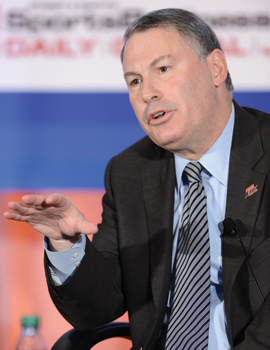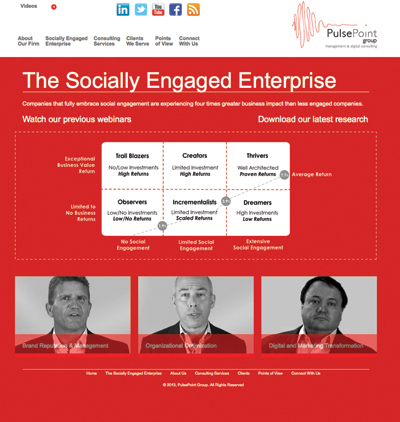Before the Big East rebranded to the American Athletic Conference earlier this month, two creative teams started with a list of 250 potential names.
Through a series of focus groups and online surveys, which weighed the opinions of more than 10,000 people, the list narrowed. The conference’s presidents assembled on a conference call April 4 to hear the four finalists, and after just one round of voting, they were unanimous in selecting the American Athletic Conference.
They were so excited about the new name that the presidents insisted on releasing the news right away, rather than waiting a day or two, so they did.
 |
“It feels like we’ve turned a corner,” says Big East Conference Commissioner Mike Aresco of the change.
Photo by: MARC BRYAN-BROWN
|
“It feels like we’ve turned a corner,” Commissioner Mike Aresco said last week.
The Big East simply wasn’t the Big East anymore. Too many schools had departed. What was left were the three holdovers — Cincinnati, Connecticut and South Florida — and nine newcomers who will enter the league between now and 2015.
The process of rebranding the conference began earlier this year once it decided to let the departing Catholic 7 take the Big East name with them. From that new beginning, it was up to a pair of creative teams to find a name for the restructured conference. One agency was the PulsePoint Group out of Austin, Texas.
PulsePoint, which has worked on branding initiatives for the Pac-12, Penn State, Utah and several others in the college space, came recommended by Pac-12 Commissioner Larry Scott. Jeff Hunt, a partner in the agency and a longtime friend of Scott’s, said that branding has become such an emphasis among schools and athletic departments that the agency’s college business has become “a really nice niche for us.”
Hunt ran point for PulsePoint, while Debbie Godfrey, a Ph.D. from Princeton who used to work at Young & Rubicam, served as the lead researcher for PulsePoint. LeslieAnne Wade, a former publicist who used to work with Aresco at CBS, also worked with the conference. She brought in MadCreek Advertising, a firm with offices in New York and New Jersey, to work on the rebranding.
Between the two sides, about 20 people were assigned to the project, which cost the conference roughly $200,000, industry experts said. Some corporate rebranding projects can run as much as $1 million to $2 million.
 |
PulsePoint Group, along with MadCreek Advertising, worked with the conference.
|
Working on parallel treks, the two teams began with what Hunt called “social listening.” Groups from each agency hovered in chat rooms and fan message boards to hear the chatter and home in on what the conference’s brand attributes should be. Hunt described it as trying to figure out what the conference’s DNA will be, a way to define the brand.
With schools in football hotbeds like Texas, Florida, Pennsylvania, Ohio and Louisiana, the firm looked at names like “Big States” that would amplify that.
Through a series of 10 or so meetings, each team came up with categories of names that used certain catch words like Metropolitan, American and States. Within each category, several derivatives emerged: The Metro, The Met, Met One, Met 1, All American, Big American, Big States, Great States.
Those names were taken to focus groups in Florida, Texas, New York and Pennsylvania, which provided valuable feedback. What the conference learned was that fans were tired of “Big” in conference names and they didn’t like the references to “Metropolitan.”
“What we’re seeing with branding these days is that people want simple rather than cutesy and clever,” Hunt said. “Call it what it is. We heard that loud and clear in our research. Metro didn’t make the cut. Fans dumped on Big. When there’s too much hyperbole, there’s not any credibility with it.”
American seemed to resonate because of the conference’s large footprint, ranging from Philadelphia to Houston. The name American 12 was one that surfaced in a variety of reports, but the conference decided to stay away from something with a number because of the volatility of conference realignment.
“The big thing is to develop an understanding of who’s in our league,” Aresco said.
Judy Genshaft, president of the University of South Florida and chair of the executive committee, said the rebirth of the conference has re-energized its member schools. “This will embody our values,” she said during the announcement.
The early reaction from the message-board cynics included this response on Collegiate Sports Nation: “At least the AAC will be the first conference listed in the new phone books.” Another proclaimed: “This conference has the most uncanny ability to form a circular firing squad for virtually every major decision,” referring to how similar The American is to Conference USA.
After establishing the conference’s name, the process now moves to establishing new logos and color schemes. MadCreek, working with Wade, will have a new American Athletic Conference brand book with marks and a color palette by the end of May. Ketchum is assisting with public relations.
The letter A will be prominent, Aresco said. On occasions when the American Athletic Conference shortens its name, it likely will be branded “The American.” The new name officially takes effect July 1.
“You’ll see some branding with just the capital A. … We’ll stay away from the AAC,” Aresco said.
The initials AAC are too similar to the ACC, and it’s also the same initials used by a smaller conference, the Appalachian Athletic Conference, a collection of NAIA schools.
Ultimately, The American stays away from identifying a specific footprint, but offers some brand attributes that the conference will highlight.
For a league that’s been nearly dismantled and maligned by realignment, “No one is going to attack our new name,” Aresco said. “It’s easy to like.”
From here, the branding strategy will seek to position The American as an upstart brand, Hunt said. It’s no longer among the five power conferences, so it has to take a different approach.
“We’re looking at it as a challenger brand, something that surprises and delights on a national stage,” Hunt said. “You sneak up on people, you’re innovative.”
Southwest Airlines is a suitable comparison, in terms of a challenger brand that “challenges the status quo, pushes the envelope,” Hunt said. “The values of America — entrepreneurship, innovation — are the values you’d associate with this conference and they’ll be tied to the brand.”
How that branding manifests itself — in commercials or other delivery methods — remains to be seen. But the new name at least gives Aresco and his 12 schools a platform from which to start anew.





